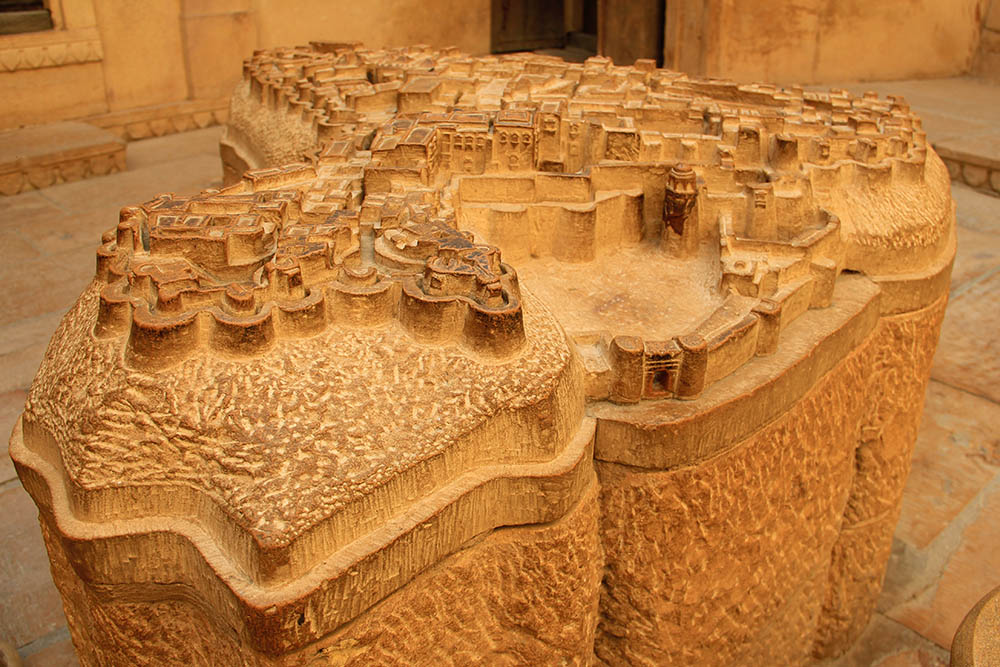 [Image: A carved sandstone model of the incredible walled fortress-city of Jaisalmer, Rajasthan, found where else but within the walled fortress-city of Jaisalmer, Rajasthan; photo by BLDGBLOG].
[Image: A carved sandstone model of the incredible walled fortress-city of Jaisalmer, Rajasthan, found where else but within the walled fortress-city of Jaisalmer, Rajasthan; photo by BLDGBLOG].
In his new book Oblique Drawing, architectural historian Massimo Scolari refers in a footnote to a story that I have to assume is familiar to many readers, but one that was new to me, connecting architectural models to acts of espionage.
“A significant example [of this connection] is reported by Vasari in the case of the siege of Florence of 1529,” Scolari explains.
During the night, Tribolo and an assistant secretly built an accurate relief model in cork, several meters wide, of the city and its fortifications. It was smuggled out of the besieged city in various pieces concealed inside bales of wool. This allowed the pope, aided by Baldassarre Peruzzi, to direct operations from a distance.
“Although the relief was made in the style of a pictorial view,” Scolari adds, “it was considered evidence of espionage.”
This cork model, meanwhile, conjures images from some as-yet-unwritten novel in which small, seemingly discontinuous models of a city are made in cork and then set floating down the river out of town; guards seeing the models float past simply assume some toymaker’s cart has overturned upstream or that a careless woodshop has tossed its inventory into the river.
But these models are acts of war, to be assembled into a complete model later, and the spatial details they reveal are the vulnerabilities of the city.
 [Image: Model of Jaisalmer; photo by BLDGBLOG].
[Image: Model of Jaisalmer; photo by BLDGBLOG].
Elsewhere, Scolari refers to other connections between spatial representations of the city and the possible military implications of those representations, once they reach their intended audience. He describes, for instance, “painter-spies who depicted the enemy’s fortresses,” under the guise of a leisurely aesthetic pursuit, and even Goethe once being forced to watched powerlessly as “local authorities” in Malcesine, Italy, “tore up the drawing he had made for his own pleasure of an abandoned castle.” After all, they reasoned, it might have been a fortifications study, or what we might call structural espionage disguised as sketching.
Among many things here, what’s interesting about all this—aside from the dizzying variety of possibilities that arise when thinking about a kind of alternative history of the architectural model as a tool for heists, espionage, assassination, and urban warfare—is that this feared dual-use of architectural images is still alive and well today. We need look no further, for instance, than to often-illegitimate photography bans inside government buildings (or subways), or limits on cameras inside retail stores, or, in the case of my trip to India earlier this year from which the above photos come, a ban on taking photographs from a boat of the Mumbai harbor and even a nationwide ban on aerial photography that was only lifted back in 2004.
In all cases, images depicting architecture are seen not as representationally innocent parts of architectural history but, we might say, as warfare by other means. Indeed, one could easily imagine an entire wing of a spy museum somewhere consisting of nothing but declassified architectural models made with whatever raw materials were available at hand, assembled for no other purpose than to undercut the very spaces they aim to depict.
